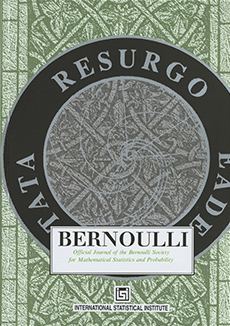Abstract
We consider the problem of estimating an unknown $n_{1}\times n_{2}$ matrix $\mathbf{\theta}^{*}$ from noisy observations under the constraint that $\mathbf{\theta}^{*}$ is nondecreasing in both rows and columns. We consider the least squares estimator (LSE) in this setting and study its risk properties. We show that the worst case risk of the LSE is $n^{-1/2}$, up to multiplicative logarithmic factors, where $n=n_{1}n_{2}$ and that the LSE is minimax rate optimal (up to logarithmic factors). We further prove that for some special $\mathbf{\theta}^{*}$, the risk of the LSE could be much smaller than $n^{-1/2}$; in fact, it could even be parametric, that is, $n^{-1}$ up to logarithmic factors. Such parametric rates occur when the number of “rectangular” blocks of $\mathbf{\theta}^{*}$ is bounded from above by a constant. We also derive an interesting adaptation property of the LSE which we term variable adaptation – the LSE adapts to the “intrinsic dimension” of the problem and performs as well as the oracle estimator when estimating a matrix that is constant along each row/column. Our proofs, which borrow ideas from empirical process theory, approximation theory and convex geometry, are of independent interest.
Citation
Sabyasachi Chatterjee. Adityanand Guntuboyina. Bodhisattva Sen. "On matrix estimation under monotonicity constraints." Bernoulli 24 (2) 1072 - 1100, May 2018. https://doi.org/10.3150/16-BEJ865
Information





